The sun, which is the nearest star to Earth, is a magnificent extraterrestrial body that has mesmerized people for countless generations. We have been given light, vitality, and conditions that are suitable for life as a result of its brilliant and warm nature. To unlock the mysteries of our cosmos, it is essential to get an understanding of the nature of the sun as well as the processes that take place within it. The warmth and light that pervade our solar system are emitted by a flaming realm that resides at the center of this wondrous extraterrestrial organism. This realm is where hydrogen is turned into energy through the process of nuclear fusion.
A fascinating process known as nuclear fusion takes place deep within the sun, where temperatures may reach an astounding 27 million degrees Fahrenheit (15 million degrees Celsius). These temperatures are reached deep within the sun. Hydrogen atoms are forced to endure extreme temperatures and pressures within this raging inferno, which results in their coming into violent contact with one another. These collisions cause the atoms to split apart, releasing their constituent subatomic particles and changing the gas into a plasma that is extremely hot. This plasma, which is made up of charged particles, is subsequently propelled into the radiative zone of the sun, where it begins a voyage that will change its course forever.
A unique phenomena known as the random walk of photons comes into play as the plasma travels across the radiative zone of the sun. Photons, which are the fundamental constituents of light, travel through the sun along a route that is as random as the movements of an intoxicated person. It takes an astonishing 170,000 years for a single photon to make it out of the core of the sun. This is because their journey is significantly slowed down by the continual interactions they have with the plasma. Although the precise length of this arduous escape is still unknown, most astronomers do not worry themselves with this topic because their attention is directed elsewhere in the wide domain of cosmic inquiry.
As the photons laboriously make their way through the inside of the sun, the convective zone eventually comes into view. The turbulent ascent of hot plasma bubbles defines the convective zone, which is the outermost layer of the interior of the sun and is formed by the convective zone itself. The heat that is produced as a result of nuclear fusion is driven toward the surface of the sun by these convective motions. This heat can then be harnessed and discharged as visible light. Because of this incredible mechanism, the sun is able to continuously supply us with radiant energy, which in turn makes it possible for life to flourish on Earth.
During a total solar eclipse, light from the universe encounters the chromosphere and the corona as it travels through the many layers of the sun’s atmosphere. When seen against the dimmed background of the moon, the chromosphere, which has a pinkish color, and the corona, which emits a brilliant white glow, put on a mesmerizing show for observers. Together, these two regions provide a spectacular sight. These ethereal displays of solar magnificence reveal the sun’s intricate and enthralling dynamics, and they have captivated the hearts and minds of astronomers and sky-watchers everywhere.
It is necessary to investigate the component parts that make up the sun’s elemental makeup in addition to the mind-boggling operations that take place within the sun. Astronomers have painstakingly catalogued 67 different chemical elements that are found within the sun, each of which plays a unique role in the genesis and development of the sun. Having said that, it is not impossible that the sun conceals other elements that have not yet been found. The study of the elemental richness of the sun gives information on the origins of the universe as well as the complex interaction of matter throughout the history of the cosmos.
As we make further progress in deciphering the mysteries of the sun, our comprehension of the cosmos as a whole grows. Radiant energy from the sun is what keeps life on Earth going and is what fuels it. This energy comes from the sun’s core, which is a flaming crucible, its turbulent convective motions, and the mesmerizing dance of photons. Because of the wealth of components it contains, it acts as a cosmic demonstration of the complicated web that makes up the cosmos. The Sun shines as a majestic fusion powerhouse in the big cosmic symphony, illuminating the solar system and enticing humanity to explore the limitless mysteries of the world. The Sun is at the center of the cosmic symphony.
![]()
